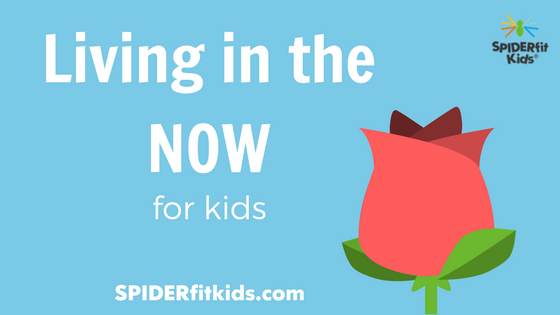by Brett Klika, CSCS
Imagine you were bestowed the superpower of being able to live solely in the moment.
No dwelling over the past, no stressing over the future — just an uncanny ability to take in and appreciate your surroundings, your company, and anything else that makes “now” pretty cool.
 The truth is, we’re born with this superpower. Much like Superman’s kryptonite however, the “stuff” in our life saps our abilities until we become mere mortals living in the anxious time machine of “what happened” and “what’s going to happen.”
The truth is, we’re born with this superpower. Much like Superman’s kryptonite however, the “stuff” in our life saps our abilities until we become mere mortals living in the anxious time machine of “what happened” and “what’s going to happen.”
This kryptonite is stronger than ever now with technology that is literally strapped to our body, ensuring we stay distracted from the sensory smorgasbord that is happening all around us.
Unfortunately, these superpower-killing devices are working their way into human life at younger and younger ages. “Now” has become boring to our kids. There’s no explosions. There’s no flying dragons. When their sensory system takes in something new, their name doesn’t appear on a leaderboard.
If kids are constantly distracted from the world around them at a young age, imagine how they will struggle to live in the “now” when they get older.
What will the ramifications be to their relationships, happiness, and health?
As adults, we’re afraid to let our children be “bored” and we run out of ideas to entertain them pretty quickly, so we default to letting a billion dollar industry do the entertaining for us.
While being entertained however, kids don’t learn to entertain themselves. It’s true that when kids entertain themselves, living room walls can become besmirched with permanent marker, siblings may vie for the house MMA title, and the general risk of harm to household items tends to rise.
However, some pretty amazing stuff happens too. The “blank slate” caused by a lack of outside stimulation breeds engagement with the world around them. Instead of their sensory system being distracted, it’s on full alert; experiencing the amazingness of “now.”
 From this emerges curiosity and a true appreciation for life. These attributes fuel a child’s ambition to move, learn, and explore — all powerful brain candy that will keep them happy and healthy for life.
From this emerges curiosity and a true appreciation for life. These attributes fuel a child’s ambition to move, learn, and explore — all powerful brain candy that will keep them happy and healthy for life.
When kids explore and play, their brains grow. When their brains grow, their bodies have more hardwiring from which to develop new ways to play and explore. This cycle continues for life — when we let it.
Resisting the temptation to use technology to appease boredom, consider how we as parents can facilitate a “reconnect” between our kids and the amazing world around them.
This reconnect can help stoke the curiosity and wonder that once inspired physical activity and play!
Furthermore, participating with our kids sets a great example and helps us turn off our exhausting mental time machine for a moment to absorb the awesomeness around us.
Next time you’re out and about, play a game with your kids.
You receive 1 point each time you’re the first person to:
- Hear an animal
- Smell and correctly identify a food
- See a specific animal, person, insect, or other living thing (The more conspicuous, the better)

You receive 2 points each time you’re the first person to:
- Hear an animal other than a dog or a bird
- Smell a tree, flower, or something else from nature.
- See a specific word, letter, number, or symbol
Consider your own point system that involves taking in surroundings wherever you are. With a little competition, it’s amazing how the whole family “tunes in” the world around them.
Try these activities instead of flipping out your phone:
- “Numbers”
Draw a letter or number on your child’s back with your finger. See if they can guess what it is. Have them do it to you. - Far Mountain Gazing
You and your child stare off into the horizon and after 30 seconds, see who can identify the furthest obscure object. - The Sounds of Nature
Close your eyes for 30 seconds and then list 5 things you heard.
- Whale Breaths
Put your hands on your belly and see who can take the longest breath in. When you can’t take in any more air, raise your hand. The last person to raise their hand wins. (No holding your breath!) - 1-Leg Blind Balance
Have your child stand on one leg with his or her eyes closed and count outloud. Once he or she lose balance, switch legs. Make it a goal to get to 30 on each leg. Now it’s your turn!
By helping facilitate the curiosity and wonder that drives moving, learning, and exploring, we help maintain the superpower that can make our kids happy and healthy for life!
For more quick and simple ideas sent right to your inbox, join our free 7 Days of Play event happening April 3rd-9th! Click here to join!
Craig Valency, MA, CSCS, president and co-founder of SPIDERfit, has been a personal trainer for the last 11 years. He is currently working at Fitness Quest 10 in San Diego, an elite personal training and athletic conditioning facility. He specializes in youth strength and conditioning programs that promote physical literacy, injury prevention and optimal performance. Along with training youths from 6 to 18 years of age for general fitness, Craig has also worked with some of the top junior tennis players in the world. He has been a physical education consultant for the Stevens Point school district in Wisconsin for the last 3 years, helping revamp the district wide programming for the K-12 PE curriculum. Craig earned his bachelor degree from UCLA, and Masters Degree in Kinesiology from San Diego State University.







Connect with SPIDERfit!